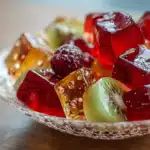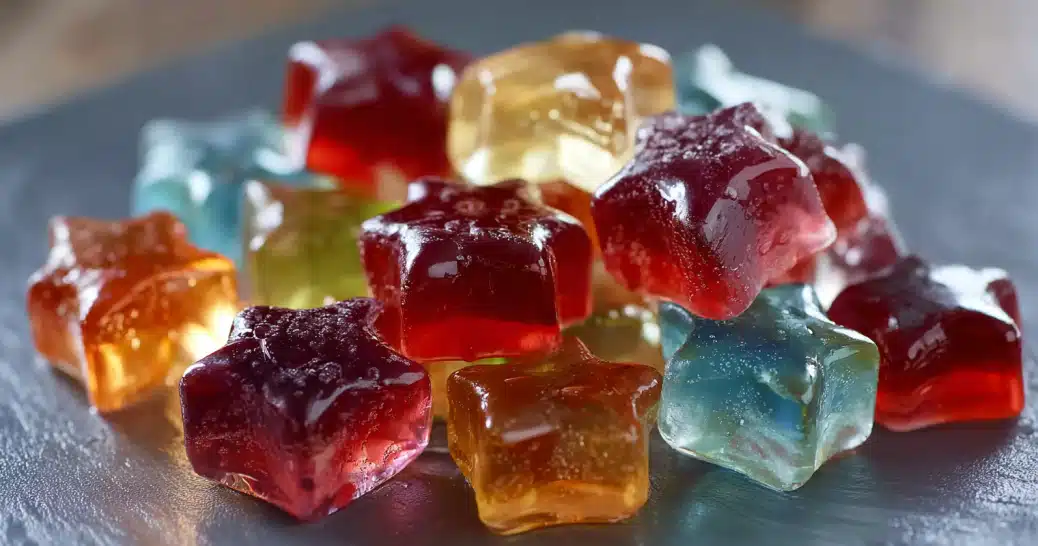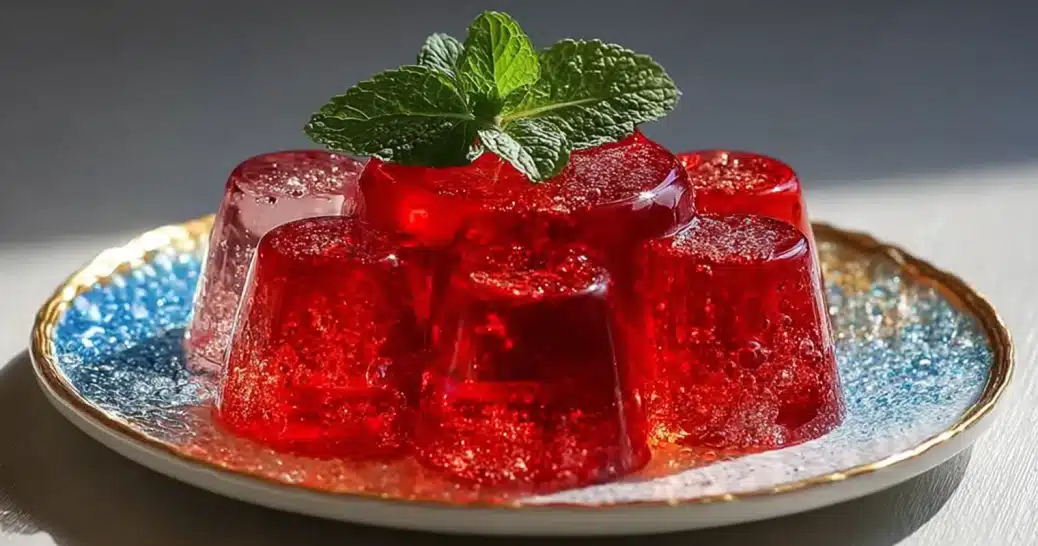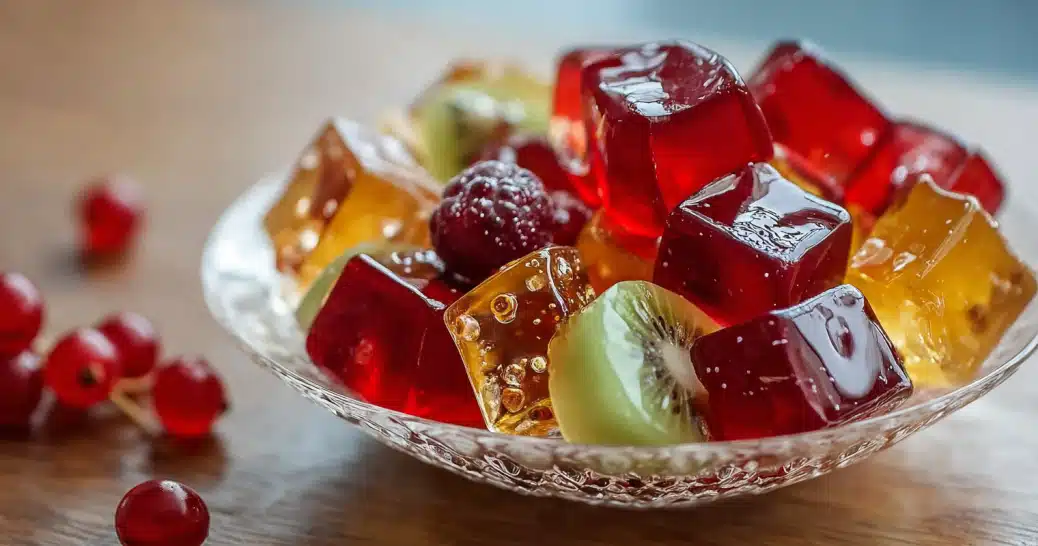If you’ve ever looked at a pack of Jell-O and hesitated after spotting gelatin on the label, you’re not alone. Gelatin, while common in desserts, is made by boiling animal bones and tissues — something vegans and plant-based eaters naturally avoid. The good news is that you don’t need animal-derived gelatin to enjoy the same fun, wobbly texture. There are amazing plant-based alternatives that let you recreate jellies, gummies, panna cotta, and fruit desserts — all 100% vegan and cruelty-free.
In this guide, we’ll walk through the best vegan gelatin substitutes you can use at home. You’ll learn how to work with ingredients like agar agar, pectin, and carrageenan to achieve perfect textures every time. We’ll also explore simple vegan gelatin substitute recipes for jello, gummies, and more. Whether you’re a home baker or a vegan dessert enthusiast, this comprehensive article will show you how to master the art of vegan gelling.
Table of Contents

Vegan Gelatin Substitute Recipes: 9 Easy Ways to Make Perfect Vegan Jello
- Total Time: 15 minutes
- Yield: 4 servings 1x
- Diet: Vegan
Description
This vegan gelatin substitute recipe creates jiggly, fruit-filled desserts using agar agar, pectin, or chia seeds—no animal gelatin needed.
Ingredients
2 cups fruit juice (orange, strawberry, grape, or your favorite blend)
1 teaspoon agar agar powder
1–2 tablespoons maple syrup or sweetener (optional)
Chopped fruit (optional, avoid fresh pineapple or kiwi)
Instructions
1. Pour juice into a saucepan. Sprinkle agar powder evenly over the surface and let it sit for 5 minutes to bloom.
2. Bring the mixture to a boil over medium heat, stirring constantly until agar is fully dissolved.
3. Stir in maple syrup or your chosen sweetener. Taste and adjust.
4. Pour into individual molds or a dish. Let cool at room temperature for 20–30 minutes.
5. Slice, scoop, or cube and enjoy chilled.
Notes
Avoid acidic juices like fresh citrus unless adjusting agar quantity.
Boiling for 1–2 minutes is enough—don’t overcook.
Agar sets quickly, so pour into molds immediately after boiling.
- Prep Time: 10 minutes
- Cook Time: 5 minutes
- Category: Dessert
- Method: No-Bake
- Cuisine: Vegan
Nutrition
- Serving Size: 1/2 cup
- Calories: 45
- Sugar: 6g
- Sodium: 5mg
- Fat: 0g
- Saturated Fat: 0g
- Unsaturated Fat: 0g
- Trans Fat: 0g
- Carbohydrates: 9g
- Fiber: 1g
- Protein: 0g
- Cholesterol: 0mg
Understanding Vegan Gelatin Substitutes
What is a Vegan Gelatin Substitute?
A vegan gelatin substitute is a plant-based ingredient that can thicken, stabilize, or gel liquids the same way traditional gelatin does, but without using animal collagen. These substitutes come from sources like seaweed, fruits, or seeds. The goal is to recreate that signature gelatin-like bounce while keeping the recipe cruelty-free. Common options include agar agar, pectin, carrageenan, chia seeds, and even starches.
Each substitute has unique properties. Agar agar creates a firm, sliceable texture. Pectin gives a soft, fruity gel that works beautifully in jams and jellies. Carrageenan offers smoothness, ideal for creamy desserts like vegan panna cotta. Understanding how these substitutes behave helps you choose the right one for your recipe.
Why Gelatin Isn’t Vegan
Traditional gelatin is made by boiling the skin, bones, and connective tissue of animals — typically cows and pigs — to extract collagen. The resulting gelatin gives desserts their jiggle but doesn’t fit into vegan or vegetarian diets. For those following a plant-based lifestyle, the texture of gelatin desserts can still be enjoyed using alternatives made from natural, plant-derived ingredients.
Replacing gelatin isn’t only about ethics. Many vegan substitutes are healthier, lower in fat, and often come with added nutritional benefits like fiber and minerals. Switching to plant-based gelling agents means you can enjoy your desserts guilt-free, with better control over the ingredients you use.
Common Plant-Based Gelling Agents Explained
Let’s look at the most popular vegan gelatin substitutes you’ll use in recipes:
| Substitute | Source | Texture | Best For |
|---|---|---|---|
| Agar Agar | Red seaweed | Firm and sliceable | Jello, puddings, gummies |
| Pectin | Apples and citrus peels | Soft and fruity | Jams, marmalades, sauces |
| Carrageenan | Seaweed extract | Smooth and creamy | Custards, panna cotta, flan |
| Chia Seeds | Plant seed | Thick, pudding-like | Breakfast bowls, layered desserts |
| Cornstarch/Tapioca Starch | Plant starch | Silky, soft set | Puddings, sauces |
Each option offers a unique texture and use. For example, agar agar is ideal for classic vegan jello because it sets quickly and holds shape well. Pectin works best in fruit-based recipes that rely on sugar and acidity for setting. Carrageenan adds body and creaminess to desserts without altering flavor.
Choosing the right vegan gelatin substitute depends on your goal. If you want a firm, clear jelly, go with agar agar. For creamy desserts, try carrageenan. And for spreadable or jam-like results, pectin will be your best friend.
The Science Behind Vegan Gelatin Alternatives
Understanding the science behind vegan gelatin substitutes helps you make desserts that not only set properly but also feel right on the spoon. Plant-based gelling agents may seem like simple replacements, but they behave differently than animal-based gelatin in texture, temperature, and stability. Once you learn how these ingredients work, you’ll be able to adjust recipes confidently and create the exact consistency you want.
How Gelatin Works vs. Plant-Based Gelling
Traditional gelatin works through collagen, which forms a flexible protein network when cooled. This network traps liquid, creating that familiar bouncy texture. In contrast, vegan gelatin substitutes rely on carbohydrates like polysaccharides from plants and seaweeds. These compounds form gels through different chemical bonds, meaning their firmness, setting time, and melting points vary.
For instance, agar agar and carrageenan create stronger bonds than gelatin, leading to a firmer texture that doesn’t melt at room temperature. That’s why agar-based desserts hold their shape even in warm weather, while gelatin desserts can soften quickly. Pectin, on the other hand, requires sugar and acid to gel, which is why it’s commonly used in jams and fruit preserves rather than molded desserts.
How Texture and Firmness Vary Among Substitutes
Each vegan gelatin substitute produces a unique texture. Understanding this helps you match the right substitute to your dessert type.
| Substitute | Texture | Firmness | Melting Point | Ideal For |
|---|---|---|---|---|
| Agar Agar | Firm and brittle | High | 85°C (185°F) | Jello, fruit gels |
| Pectin | Soft and elastic | Medium | 80°C (176°F) | Jams, jellies |
| Carrageenan | Creamy and smooth | Medium | 70°C (158°F) | Custards, flans |
| Chia Seeds | Thick and spoonable | Low | No melting | Puddings |
| Cornstarch | Soft and silky | Low | 60°C (140°F) | Custards, sauces |
If you prefer a sliceable, jiggly dessert, agar agar is the best option. For a spreadable texture like a fruit compote, pectin will be perfect. Carrageenan adds a smooth, dairy-like consistency that’s ideal for mousse or panna cotta.
Temperature, pH, and Setting Behavior
Temperature and pH levels play a big role in how vegan gelatin substitutes perform. Unlike gelatin, which sets at cooler temperatures, agar agar needs to boil to activate. Once dissolved and cooled, it sets quickly, often within 20 to 30 minutes. That’s why timing is important when making vegan jello.
Acidity also affects how well your dessert sets. For example, citrus juices can weaken the gelling ability of agar agar and pectin. To fix this, slightly increase the amount of your gelling agent when using lemon, lime, or orange juice. For agar agar, use about one and a half teaspoons per cup of acidic liquid instead of the usual one teaspoon.
Water content matters too. Too much liquid makes the dessert soft or runny, while too little can make it rubbery. Always measure your ingredients carefully and remember that vegan substitutes require precision for perfect results.
Pro tip: When experimenting, start with small batches until you find your preferred texture. Once you master the ratios, you can scale up your recipe easily.
Agar Agar – The Most Popular Vegan Gelatin Substitute
When it comes to vegan gelatin substitute recipes, agar agar is the superstar ingredient. It is one of the most versatile, reliable, and accessible gelling agents for vegan desserts. Derived from red seaweed, agar agar offers a clean, firm set and neutral flavor, making it ideal for everything from jello cubes to elegant panna cottas.
What is Agar Agar and How is It Made?
Agar agar, often just called agar, is a plant-based gelling substance extracted from red algae. It’s been used in Asian cuisines for centuries, especially in Japan and Indonesia. The word “agar” actually comes from the Malay word for jelly.
The extraction process involves boiling red algae to release its natural polysaccharides, which are then dried and powdered. The result is a fine, tasteless powder that dissolves easily in liquid when heated. Because agar agar sets firmly and doesn’t melt until about 185°F, it’s a favorite for vegan jello, fruit gels, and gummy candies.
Agar is available in several forms, including powder, flakes, and bars. For dessert recipes, agar powder is the easiest to measure and dissolves the fastest.
How to Use Agar Agar in Vegan Jello Recipes

Using agar agar in vegan gelatin substitute recipes is simple once you understand how it behaves. Unlike animal gelatin, agar agar needs to be boiled to activate. The general ratio is 1 teaspoon of agar powder to 1 cup of liquid, which creates a firm, sliceable texture.
Here’s the step-by-step process:
- Mix your agar agar powder with room-temperature liquid, such as fruit juice, plant-based milk, or water. Let it sit for five minutes to bloom.
- Bring the mixture to a full boil over medium heat, stirring constantly until completely dissolved.
- Add sweeteners or flavorings like maple syrup, sugar, or vanilla extract.
- Pour the hot liquid into molds or a shallow dish.
- Let it set at room temperature for about 20 to 30 minutes.
Once set, agar agar desserts can be sliced cleanly and retain their shape even at room temperature. If you prefer a softer texture, reduce the agar powder slightly to ¾ teaspoon per cup of liquid.
Pro Tips for Perfect Agar-Based Desserts
Getting the perfect texture with agar agar takes a little practice. Here are expert tips to help you succeed every time:
- Avoid overcooking. Once the agar is fully dissolved, remove it from heat promptly to prevent toughness.
- Work quickly. Agar sets fast, often within minutes as it cools. Have your molds ready before you start boiling.
- Handle acidic liquids carefully. Citrus, pineapple, and kiwi juices can weaken agar’s gelling power. If using these, increase agar slightly or pre-cook the juice.
- Mix for clarity. If you want a transparent vegan jello, dissolve agar completely and avoid stirring once poured.
- Combine with other ingredients. Agar can be paired with coconut milk, coffee, or fruit puree to make layered desserts or vegan panna cotta.
Agar agar’s versatility makes it the best choice for beginners learning how to make vegan gelatin substitute recipes. You can easily experiment with flavors, from tropical mango to espresso or matcha. The results are always firm, glossy, and impressive.
If you’re looking for that classic wobbly jello texture without animal gelatin, agar agar will quickly become your go-to plant-based ingredient.
Pectin and Carrageenan – Fruit and Seaweed Powerhouses
Not every vegan gelatin substitute behaves the same way as agar agar. Two other incredible plant-based gelling agents, pectin and carrageenan, offer different textures and uses that make vegan gelatin substitute recipes even more versatile. Both are natural, plant-derived ingredients that bring their own strengths to vegan desserts, jams, and creamy puddings.
Using Pectin for Fruit Jellies and Jams
Pectin is a naturally occurring fiber found in fruits, especially apples and citrus peels. It’s the magic behind the thick, spreadable consistency of jams and marmalades. In vegan gelatin substitute recipes, pectin works beautifully for soft, fruity jellies that feel lighter and more delicate than agar-based desserts.
Pectin requires two things to activate properly — sugar and acid. These elements help the pectin form a gel network that traps liquid. The process is simple, but precise ratios are important for success.
Basic Pectin Jelly Formula:
- 1 cup fruit juice
- 2 tablespoons sugar (or sweetener)
- 1 tablespoon lemon juice (for acidity)
- 1 tablespoon pectin powder
Steps:
- Mix the pectin with sugar first to prevent clumping.
- Heat the fruit juice and lemon juice in a saucepan.
- Stir in the pectin-sugar blend and bring it to a gentle boil.
- Simmer for 1 to 2 minutes, then pour into molds or jars.
- Let it cool completely to set.
The result is a soft, spoonable jelly with a pure fruit flavor. If you want a firmer set, add a bit more pectin, but remember that pectin creates a softer gel than agar agar, so it’s not ideal for layered or molded jello desserts.
Carrageenan for Creamy Desserts and Panna Cotta
Carrageenan is another seaweed-derived gelling agent that’s often used in vegan and dairy-free desserts. It gives a smooth, creamy consistency that makes it perfect for puddings, mousses, and vegan panna cotta. Unlike agar agar, carrageenan doesn’t produce a stiff gel. Instead, it provides a silky, melt-in-your-mouth texture.
There are several types of carrageenan, but the two most common for cooking are kappa and iota.
- Kappa carrageenan creates a firmer, elastic gel that’s great for puddings or firm custards.
- Iota carrageenan forms a softer, creamier gel suitable for mousse-style desserts.
Basic Carrageenan Dessert Formula:
- 2 cups plant-based milk (like coconut or almond milk)
- 1 teaspoon carrageenan powder
- 2 tablespoons sugar
- ½ teaspoon vanilla extract
Instructions:
- Mix carrageenan powder into cold plant milk.
- Heat gently while stirring until it thickens slightly.
- Add sugar and flavoring, then pour into small cups or molds.
- Cool at room temperature to set.
Carrageenan is particularly good at holding creamy mixtures together without separating, giving vegan panna cotta or mousse a professional texture. Its mild taste allows your chosen flavors — whether vanilla, chocolate, or coffee — to shine through.
Comparing Pectin and Carrageenan to Agar Agar
| Feature | Agar Agar | Pectin | Carrageenan |
|---|---|---|---|
| Source | Seaweed | Fruit | Seaweed |
| Texture | Firm and sliceable | Soft and spreadable | Creamy and smooth |
| Needs Acid/Sugar | No | Yes | No |
| Best For | Jello, gummies | Jams, fruit gels | Panna cotta, mousse |
| Setting Temperature | Room temp | Cools slowly | Room temp |
While agar agar is best for firm jello-like desserts, pectin shines in fruity recipes, and carrageenan is unbeatable for creamy, dairy-free desserts. Together, they cover almost every texture you might want when creating vegan gelatin substitute recipes.
If you’re building a dessert menu or experimenting at home, mastering these three ingredients gives you endless possibilities for vegan sweets. Whether you want a glossy fruit jelly, a soft jam, or a rich pudding, these natural gelling agents make it easy to stay plant-based without sacrificing taste or texture.
Easy Vegan Gelatin Substitute Recipes

Now that you understand how agar agar, pectin, and carrageenan work, it’s time to put them to use. This section explores a few simple and delicious vegan gelatin substitute recipes that prove you don’t need animal-based gelatin to create desserts with perfect texture and flavor. These recipes use common pantry ingredients and easy-to-follow steps that anyone can master.
Vegan Jello with Fruit Juice
Classic jello gets a cruelty-free makeover with this easy vegan gelatin substitute recipe. The result is firm, bright, and naturally flavored with fruit juice.
Ingredients:
2 cups fruit juice (such as strawberry, orange, or grape)
1 teaspoon agar agar powder
1 tablespoon maple syrup or sugar
Optional: diced fruit for extra texture
Instructions:
Combine the juice and agar powder in a saucepan and let sit for 5 minutes.
Bring the mixture to a gentle boil over medium heat, stirring until the agar completely dissolves.
Add sweetener and mix well.
Pour the mixture into molds or a dish and allow it to cool at room temperature.
Once firm, chill for an hour before serving.
This simple vegan gelatin substitute recipe delivers the same jiggly, satisfying feel as traditional jello but is entirely plant-based. Use fruit juices like mango or cranberry for added color and natural sweetness.
Vegan Coffee Jelly
Coffee jelly is a sophisticated dessert that tastes both indulgent and refreshing. This version uses agar agar for a firm texture and pairs beautifully with oat or coconut milk.
Ingredients:
2 cups brewed coffee
1 teaspoon agar agar powder
2 teaspoons sugar (adjust to taste)
Plant-based cream for serving
Instructions:
Mix the agar powder with brewed coffee in a saucepan.
Bring to a boil and stir until dissolved.
Add sugar and simmer for another minute.
Pour the mixture into a dish and let cool to set.
Cut into cubes and serve with plant-based cream or cold oat milk.
This dessert adds variety to your vegan gelatin substitute recipes collection and is perfect for coffee lovers who want a light but flavorful finish to a meal.
Homemade Vegan Gummies
These fun, chewy vegan gummies are a hit with both kids and adults. They’re also a great way to explore texture control when working with vegan gelatin substitute recipes.
Ingredients:
1 cup fruit juice (apple, cherry, or mixed berry)
1 teaspoon agar agar powder or pectin
1 tablespoon agave or sugar
Silicone molds
Instructions:
Combine juice and agar powder in a small pot. Let sit for 3–5 minutes.
Heat until boiling and stir continuously for one minute.
Add sweetener and mix thoroughly.
Pour the liquid into silicone molds.
Allow to cool and set completely before removing.
Agar makes firm, springy gummies, while pectin yields a softer, melt-in-your-mouth chew. Both versions are delicious and prove how flexible vegan gelatin substitutes can be.
Tips for Successful Vegan Gelatin Substitute Recipes
Always measure your gelling agents carefully. A small difference can change the texture.
Use filtered juice or water for a clear finish.
Avoid using fresh pineapple or kiwi unless cooked, as enzymes prevent setting.
Chill your desserts for at least an hour before serving for the best results.
For added shine, brush the surface lightly with syrup once the jello has set.
With these simple vegan gelatin substitute recipes, you can make desserts that are fun, flavorful, and 100% plant-based. Whether you prefer a sweet fruit jelly, a bold coffee jelly, or chewy vegan gummies, each recipe highlights how effective plant-based gelling can be.
Making Vegan Jello Without Agar Agar
While agar agar is the most popular option in vegan gelatin substitute recipes, it’s not the only way to create delicious, jiggly, plant-based desserts. You can still achieve excellent texture using pantry staples like chia seeds, cornstarch, or tapioca starch. Each offers unique results, from pudding-like softness to a light, spoonable gel.
Chia Seeds as a Natural Gelling Option
Chia seeds are a nutrient-dense, all-natural alternative that forms a gel without heat or complicated steps. When soaked in liquid, these tiny seeds expand and create a thick, pudding-like texture perfect for breakfast bowls and light desserts.
Ingredients:
- 1 cup almond milk or fruit juice
- 3 tablespoons chia seeds
- 1 tablespoon maple syrup or agave
- Optional toppings: fruit, nuts, or coconut flakes
Instructions:
- Mix the chia seeds, milk, and sweetener in a bowl.
- Stir well to prevent clumping.
- Let the mixture rest for 5 minutes, then stir again.
- Refrigerate for 2 to 3 hours, or overnight, until thick and creamy.
This chia-based treat isn’t identical to jello in bounce, but it’s rich in fiber, omega-3 fatty acids, and plant protein. For anyone who prefers a naturally thick, spoonable texture, this is one of the healthiest vegan gelatin substitute recipes available.
Using Cornstarch and Tapioca Starch for Pudding-Style Desserts
If you want a softer texture similar to custard or pudding, cornstarch and tapioca starch work beautifully. These starches thicken when heated, giving a creamy consistency that melts on the tongue.
Cornstarch Jello Base:
- 2 cups fruit juice
- 3 tablespoons cornstarch
- 2 tablespoons sugar or sweetener
Instructions:
- Whisk cornstarch and sugar into cold juice until smooth.
- Heat the mixture over medium heat, stirring constantly.
- Once thickened and glossy, pour into serving cups.
- Let cool, then refrigerate for at least 1 hour.
Tapioca Starch Variation:
For a slightly elastic, bouncy feel, replace cornstarch with tapioca starch. The texture will be stretchier and more translucent, making it great for bubble-tea-style desserts or chewy vegan jellies.
Both methods create silky vegan treats without needing agar agar or any seaweed-based ingredients. They’re also ideal for those with sensitivities to agar or carrageenan.
Pros and Cons of Agar-Free Vegan Jello
| Feature | Chia Seeds | Cornstarch | Tapioca Starch |
|---|---|---|---|
| Texture | Thick and spoonable | Silky and soft | Elastic and chewy |
| Heat Required | No | Yes | Yes |
| Nutrition | High fiber, omega-3s | Low calorie | Gluten-free |
| Ideal For | Puddings, parfaits | Custards | Bubble jellies |
Pros:
- Easy to find in any grocery store
- Simple preparation
- Flexible textures for different desserts
- Healthier and natural ingredients
Cons:
- Softer than agar agar-based jello
- Some versions don’t hold shape well for molded desserts
If you’re experimenting with vegan gelatin substitute recipes, these agar-free options open up a new world of textures. You can create everything from chia pudding to soft, spoonable fruit desserts using only plant-based ingredients already in your kitchen.
Whether you’re avoiding agar for dietary reasons or just want to experiment with other methods, these approaches prove that vegan desserts can be simple, creative, and full of texture without animal products.
Healthy Vegan Gelatin Recipes
Desserts don’t have to be full of sugar or artificial colors to taste amazing. One of the biggest benefits of making your own vegan gelatin substitute recipes is that you control every ingredient. With simple swaps and natural boosters, you can create jiggly, flavorful treats that are not only plant-based but also packed with nutrients.
Low-Sugar and Naturally Sweetened Options
Most traditional jello recipes rely on refined sugar. In contrast, vegan versions can use clean, natural sweeteners that add depth and nutrition without empty calories.
Here are some of the best options for sweetening vegan gelatin substitute recipes naturally:
| Sweetener | Flavor Profile | Health Benefit |
|---|---|---|
| Maple Syrup | Rich and caramel-like | Contains antioxidants and minerals |
| Date Syrup or Pureed Dates | Sweet and fruity | Adds fiber and natural vitamins |
| Agave Syrup | Neutral and mild | Works well with citrus or berry flavors |
| Stevia or Monk Fruit | Very sweet | Great for low-carb or diabetic-friendly desserts |
| Coconut Sugar | Deep, earthy flavor | Lower glycemic index than white sugar |
These sweeteners blend easily into vegan gelatin mixtures and enhance natural fruit flavors. When you use juices like mango, grape, or orange, you may not need any added sugar at all.
Boosting Nutrition with Superfoods and Natural Colors
Healthy vegan gelatin substitute recipes can go beyond dessert and double as nutritious snacks. Add functional ingredients to increase fiber, antioxidants, and vitamins while giving your jello vibrant, natural colors.
Try these nutrient-packed add-ins:
- Chia Seeds: Add crunch and fiber while helping the dessert thicken naturally.
- Beet Juice: Offers a deep red hue with antioxidants.
- Spirulina: Creates a bright green color and adds plant protein.
- Mango Puree: Adds tropical sweetness and vitamin A.
- Coconut Cream: Makes layers rich, creamy, and satisfying.
By combining these natural boosters, you can turn a simple treat into a superfood dessert. The best part is that these ingredients don’t compromise taste or texture.
Tips for Storing and Serving Healthy Vegan Desserts
Healthy vegan gelatin substitute recipes store well in the refrigerator for three to five days, depending on the base ingredient. To maintain freshness and texture, follow these quick tips:
- Use airtight containers. Vegan jello can absorb fridge odors easily, so store it sealed.
- Keep it cool, not frozen. Freezing changes the gel structure and makes the texture grainy.
- Add fresh fruit only after setting. Some fruits, like pineapple and kiwi, can interfere with gelling if added too soon.
- Layer flavors. Combine a creamy layer (like coconut milk and agar) with a fruity layer (like orange juice) for visual appeal and contrast.
- Serve chilled. Vegan gelatin desserts taste best when served cold but not icy.
Healthy vegan jello recipes don’t need to feel like a compromise. When made with the right plant-based gelling agents and wholesome ingredients, they become delicious desserts you can enjoy every day.
Whether you’re watching your sugar intake, eating clean, or just want a nutritious dessert, these vegan gelatin substitute recipes let you indulge while staying aligned with your health goals.
Troubleshooting and Texture Tips
Even with the best vegan gelatin substitute recipes, getting the perfect set or texture can sometimes take a little trial and error. Small differences in temperature, liquid type, or ingredient ratio can change the final result. Luckily, a few expert tips can help you troubleshoot common issues and achieve perfect vegan jello every time.
Common Setting Issues and How to Fix Them
Sometimes your vegan dessert might not set as firmly as you expected, or it could turn out rubbery or watery. Here are the most common reasons this happens and simple ways to fix them.
| Problem | Cause | Solution |
|---|---|---|
| Too soft or runny | Not enough agar, pectin, or starch | Increase gelling agent slightly and reheat mixture before pouring again |
| Too firm or rubbery | Too much agar agar or overcooked mixture | Reduce agar by ¼ teaspoon per cup of liquid next time |
| Won’t set at all | Acidic ingredients like citrus or pineapple | Pre-cook fruit juice or increase gelling agent to strengthen the bond |
| Cloudy texture | Stirring too much after pouring | Pour gently and avoid movement while setting |
| Grainy surface | Undissolved agar particles | Make sure to fully boil agar mixture before setting |
The key to success in vegan gelatin substitute recipes is patience and precision. A little practice goes a long way in mastering these plant-based gels.
Adjusting Firmness Levels
The beauty of working with vegan gelatin substitutes is how customizable they are. You can easily make your desserts softer, firmer, or bouncier by changing the amount of gelling agent or liquid.
For a softer texture:
Use ¾ teaspoon agar agar or ¾ tablespoon pectin per cup of liquid. This ratio works well for creamy puddings or desserts that need a delicate bite.
For a firmer texture:
Use 1 to 1¼ teaspoons agar agar or 1½ tablespoons pectin per cup of liquid. This setting works best for molded jellies or fruit cubes that need to hold shape.
For a chewy, gummy feel:
Use 1½ teaspoons agar agar or blend agar with pectin. This creates that fun gummy candy texture often used in vegan gummy bear recipes.
Getting your desired consistency is as simple as experimenting with small batches until you find the perfect balance for your preferred texture.
Best Liquids and Fruit Combinations for Clear Vegan Jello
Clarity and flavor go hand in hand when it comes to vegan gelatin substitute recipes. Some fruits and juices naturally produce clear gels, while others turn opaque or cloudy.
Best liquids for clear vegan jello:
- Apple juice
- White grape juice
- Green tea
- Lemon water (adjusted for acidity)
- Coconut water
Best fruits for adding flavor and color:
- Mango
- Strawberry
- Blueberry
- Raspberry
- Orange
Avoid fresh pineapple, kiwi, papaya, or figs in raw form. These fruits contain enzymes that break down the structure of agar and pectin, preventing the mixture from setting properly. If you want to use them, lightly cook them before mixing with your vegan gelatin base.
Pro tip: To achieve restaurant-quality clarity, strain your liquid through a fine mesh or cheesecloth before adding the gelling agent. This removes pulp and ensures a glassy, professional finish.
Bonus Tip: Layering for Visual Appeal
Layered jellies are a fun and creative way to show off your vegan gelatin substitute recipes. Alternate layers of creamy coconut milk and bright fruit juice for an eye-catching dessert. Let each layer set before adding the next to prevent colors from bleeding together.
The final result is a vibrant, multi-layered vegan jello that looks stunning and tastes even better.
Conclusion
Exploring vegan gelatin substitute recipes opens up a world of creative, colorful, and cruelty-free desserts. Whether you’re crafting chewy vegan gummies, smooth panna cotta, or classic fruit jello, there’s a plant-based option that works perfectly for you.
Agar agar gives you firm, glossy results for molded desserts. Pectin shines in fruity jams and jellies. Carrageenan delivers creamy, melt-in-the-mouth textures. Even pantry staples like chia seeds or cornstarch can replace gelatin in simple, wholesome recipes.
By mastering these vegan-friendly gelling agents, you’ll never miss traditional gelatin again. Plus, they come with added benefits — healthier ingredients, ethical sourcing, and the satisfaction of creating desserts that align with your values.
If you want to keep exploring plant-based dessert techniques, visit our community discussions and shared recipe collections on Facebook and Pinterest, where you’ll find hundreds of creative vegan dessert ideas and plating inspirations from passionate home cooks just like you.
FAQs About Vegan Gelatin Substitutes
Before wrapping up this complete guide to vegan gelatin substitute recipes, let’s answer some of the most common questions people have about plant-based gelatin alternatives. These quick insights will help you make smarter choices in your kitchen and get the most out of every vegan dessert you prepare.
What is a vegan alternative to gelatin?
The best vegan alternative to gelatin is agar agar, a seaweed-based gelling agent that works beautifully in vegan jello, puddings, and gummies. Agar agar creates a firm, stable gel that doesn’t melt at room temperature. Other excellent substitutes in vegan gelatin substitute recipes include pectin, carrageenan, and chia seeds, depending on the texture you want.
What do they use instead of gelatin in vegan sweets?
In vegan sweets, chefs and home cooks use a variety of gelling ingredients like agar agar, pectin, and carrageenan. For soft textures like fruit jams, pectin is the most popular choice. For creamy desserts such as panna cotta, carrageenan provides a smooth finish. Agar agar remains the most versatile and reliable base in modern vegan gelatin substitute recipes.
Is there a vegan version of jello?
Yes, there are many vegan versions of jello that set perfectly without using animal products. By substituting gelatin with agar agar or pectin, you can create the same classic jiggle and flavor. Many brands now sell pre-mixed vegan gelatin substitute recipes in powder form, or you can make your own at home using natural fruit juice and agar powder for a completely customizable treat.
Why do vegans avoid gelatin?
Vegans avoid gelatin because it is derived from animal collagen, typically sourced from bones and connective tissue. In contrast, vegan gelatin substitute recipes rely on ingredients from plants and seaweed, making them cruelty-free and suitable for a plant-based diet. These vegan versions also tend to be healthier and lighter, containing no cholesterol or animal fat.
Can vegan gelatin substitutes replace gelatin in any recipe?
Yes, in most cases you can replace gelatin with a vegan alternative like agar agar or pectin. However, it’s important to adjust the ratios since plant-based gelling agents work differently. Agar agar sets firmer and faster than gelatin, while pectin needs sugar and acid to activate. When testing new vegan gelatin substitute recipes, always start small until you find your ideal consistency.
How long do vegan gelatin desserts last?
Vegan gelatin desserts generally last three to five days when refrigerated in an airtight container. Agar agar and carrageenan-based desserts hold up best over time, while pectin and chia-based recipes are best consumed within two to three days for optimal texture and flavor. If you plan to store vegan gelatin substitute recipes, keep them chilled and covered to prevent moisture loss or odor absorption.











